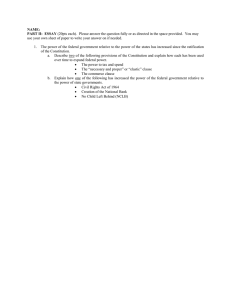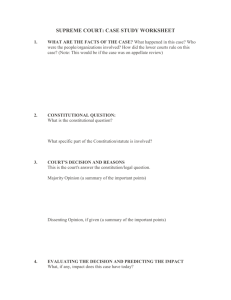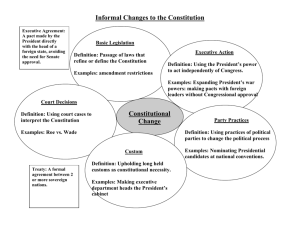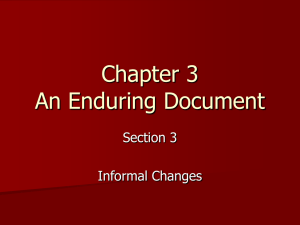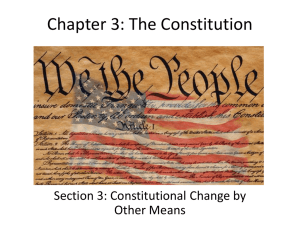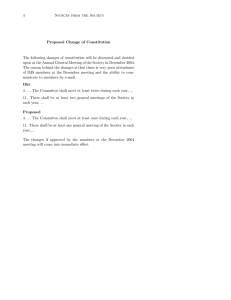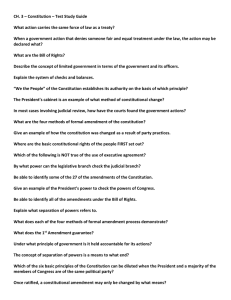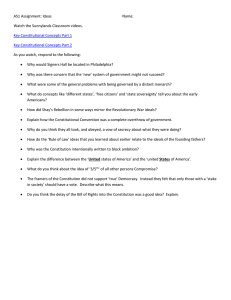+ 2 (,1 1/,1(
advertisement
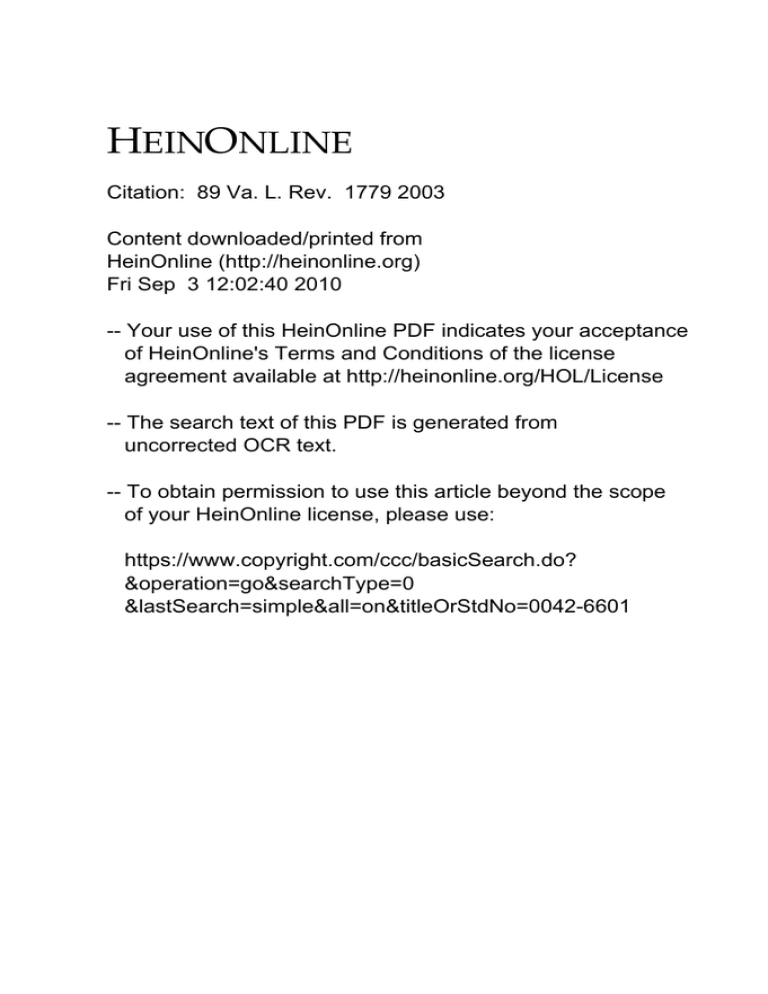
+(,121/,1( Citation: 89 Va. L. Rev. 1779 2003 Content downloaded/printed from HeinOnline (http://heinonline.org) Fri Sep 3 12:02:40 2010 -- Your use of this HeinOnline PDF indicates your acceptance of HeinOnline's Terms and Conditions of the license agreement available at http://heinonline.org/HOL/License -- The search text of this PDF is generated from uncorrected OCR text. -- To obtain permission to use this article beyond the scope of your HeinOnline license, please use: https://www.copyright.com/ccc/basicSearch.do? &operation=go&searchType=0 &lastSearch=simple&all=on&titleOrStdNo=0042-6601 BOOK REVIEW REVIEW OF STRUCTURE AND RELATIONSHIP IN CONSTITUTIONAL LAW John Harrison* Structure and Relationship in ConstitutionalLaw. By Charles L. Black, Jr. Louisiana State University Press. 1969. But Professor Gilmore also espouses a more radical position, one that I hate a lot, and that I do not hate less just because it is almost certainly true. Professor Arthur Allen Leff' T HIS is a book that I love, and that I do not love any less just because I think that it is in important ways incorrect. Indeed, my theme will be that even when the book is wrong, it is right. In 1968, Professor Charles Black delivered the Edward Douglas White lectures at Louisiana State University. Published as Structure and Relationship in ConstitutionalLaw,' those lectures are a major intellectual achievement. Brief and unburdened with apparatus, they present an argument about how American constitutional reasoning is, and should be, done. Perhaps because of their content, perhaps because of Professor Black's memorable prose, they have had substantial influence ever since. Professor Black began by identifying the two basic forms of legal reasoning that dominate American law. "One is the method of * D. Lurton Massee Professor and Horace W. Goldsmith Research Professor, University of Virginia School of Law. The editors of the Virginia Law Review suggested that I write a review of some work other than a recent publication in law, perhaps even of a nonlegal work. While Charles Black, a poet in his spare time, easily could have undertaken the latter task, it is probably better for all concerned that the closest I come to critically confronting literature is to review a classic legal work by a man whose prose itself is poetic. 'Arthur Allen Leff, Law and, 87 Yale L.J. 989,1010 (1978). ' Charles L. Black, Jr., Structure and Relationship in Constitutional Law (1969). 1779 HeinOnline -- 89 Va. L. Rev. 1779 2003 1780 Virginia Law Review [Vol. 89:1779 precedent, the finding of sound analogy in the past case or line of cases."3 The other was "the searching of the written text for its meaning in application to the presented case."' But those venerable modes of thought were not his subject. What I shall discuss is the great extent to which, in dealing with questions of constitutional law, we have preferred the method of purported explication or exegesis of the particular textual passage considered as a directive of action, as opposed to the method of inference from the structures and relationships created by the constitution in all its parts or in some principal part.' That preference, Professor Black maintained, was a mistake because of the great power of the method of structure and relationship. His first example by way of comparison was the then-recent Carringtonv. Rash.6 In that case, the United States Supreme Court held invalid a Texas constitutional provision under which members of the federal armed forces were not permitted, while in the service, to establish residency in Texas for voting purposes.7 To reach this result, the Court relied on its favorite tool in those heady Warren Court days, the Equal Protection Clause, finding that Texas had made an arbitrary distinction based on military service.' Professor Black's reply was: Right result, wrong reason. The differential treatment of military personnel was not arbitrary or irrational because soldiers are not like other voters; their ties to the places where they live are not like those of ordinary residents.9 Nevertheless, Texas had departed from the demands of the federal structure. Its law represented "the imposition, by a state, of a distinctive disadvantage based solely on membership in the Army. My thought would be that it ought to be held that no state may annex any disadvantage simply and solely to the performance of a federal duty."'" Surely, Professor Black argued, the Constitution must imply some such doctrine. A state could not make it a crime to file 3 Id. 4Id. at4. at 5. 'Id. at 7. 6380 U.S. 89 (1965). 'Id. at 96-97. Id. at 96. 'Black, supra note 2, at 10. "'Id. at 11. HeinOnline -- 89 Va. L. Rev. 1780 2003 2003] Structureand Relationship 1781 suit in federal court, or disenfranchise people who had once served in the Army, although the Constitution does not explicitly forbid such actions." If that is true, the question is just about the contours of the structurally derived limitations, not their existence. The proper citation in Carrington, Professor Black said,'2 was not the Equal Protection Clause, but rather the same structural principle of federal immunity that underlay McCulloch v. Maryland." It seems to me that Professor Black was right about the importance of structurally derived limitations, but wrong about their under-use. This appears from his leading example, the so-called dormant commerce clause. The textual argument to that doctrine is, as Professor Black noted, ungainly at best; it "never was a very good one."' 4 Rather, "[t]he sense of the matter seems to come from a concept of economic interdependence which is not so much implied logically or legally in the commerce clause as it is evidenced by that clause as well as by other things, including even the Preamble."'5 Understanding the matter that way "might have shortcircuited much difficulty, above all by making it instantly quite clear what had to be talked about, without metaphysical complications, if one would justify a result at the concrete level."' 6 This is very likely true, and for many decades the Supreme Court may well have thought something quite similar. As Professor Barry Cushman has explained in lucid detail, from the 1870s to the 1930s the Court's Commerce Clause doctrine simultaneously required that the states respect a national market through the so-called dormant commerce clause and determined the scope of Congress's affirmative power under the textual Commerce Clause.'7 Just as Professor Black would have wished, the Court had an integrated view of the national system. In order to protect the national market "Id. at 12. 12 Id. at 23-24. 17 U.S. (4 Wheat.) 316 (1819). Black, supra note 2, at 21. The textual problem is that the commerce power is not by its terms exclusive, U.S. Const. art. I, § 8, cl. 3, and there is nothing illogical in thinking that Congress and the states have concurrent power over interstate commerce until Congress chooses to displace state law, as it may do thanks to the Supremacy Clause of Article VI. Id. art. VI, cl. 2. " Black, supra note 2, at 21. 16Id. at 22. 14 "Barry Cushman, Formalism and Realism in Commerce Clause Jurisprudence, 67 U. Chi. L. Rev. 1089 (2000). HeinOnline -- 89 Va. L. Rev. 1781 2003 1782 Virginia Law Review [Vol. 89:1779 of which Professor Black wrote, the dormant commerce clause doctrine denied the states power to regulate many activities that qualified as interstate commerce.'" This created a regulatory gap that could be filled by Congress. Thus, for example, in Minnesota v. Barber the Court decided that the states' power to regulate food safety did not allow them to block imports of non-complying cattle, or to forbid the first sale of such cattle.' 9 This created a gap. In response, Congress enacted the Meat Inspection Act of 1891, imposing federal standards on livestock shipped interstate." Once the Court had determined that a particular category of transaction was in the gap in state power, that category was subject to federal power. The restrictions on state power were the large purpose of the doctrine, and affirmative federal power existed mainly in order to solve a problem the restrictions created, not in order to give Congress a general authority over economic issues. This principle of the complementarity of state and federal power is structural, not mainly textual, and it seems relatively clear from Professor Cushman's account that this structural insight made the running for the Court. On the charge of neglect of structure, then, the doctrine must be acquitted. As for the charge of undue, metaphysical focus on the text, I think the verdict there must be not guilty as well. For, while the text was secondary, it was hardly irrelevant, providing with the word "commerce" a constant reminder that the point was to divide local and national authority so as to ensure free trade, that is to say free commerce, without central control of economic activity in general. One may or may not like the resulting doctrine, with its stress on the distinction between production and commerce, but as an intellectual structure it represented a compelling implementation of a large-scale vision inspired by the concrete text. Charles Black, it seems to me, would have commended it on methodological, if not substantive, grounds. '""As the national economy became increasingly integrated in the years following the Civil War, the Court began a conscious and increasingly aggressive campaign to break down local barriers to interstate trade through a 'free-trade' construction of the dormant Commerce Clause." Id. at 1101. 1.36 U.S. 313 (1890). 20 Meat Inspection Act of 1891, ch. 555, § 3, 26 Stat. 1089, 1090. HeinOnline -- 89 Va. L. Rev. 1782 2003 Structure and Relationship 2003] 1783 It seems unlikely that he would have commended the Court's current state sovereign immunity doctrine on any grounds, but the highly controversial Rehnquist Court cases establishing that doctrine are all about structure and hardly at all about text. According to the Court's cases, states of the Union may not be sued without their consent except by other states of the Union or the United States.2 This is true in both state and federal court, which means that it does not derive from the Eleventh Amendment, the sole explicit indication in the constitutional text of sovereign immunity.22 Moreover, the doctrine applies even when Congress has substantive power to regulate the states, and is thus a special limitation on remedies that has no identifiable source in the text, not an outof the textually supported principle of enumerated powgrowth 23 ers. Once again the Court is implementing a view of the federal structure that has no warrant in the words. [A]s the Constitution's structure, its history, and the authoritative interpretations by this Court make clear, the States' immunity from suit is a fundamental aspect of the sovereignty which the States enjoyed before the ratification of the Constitution, and which they retain today (either literally or by virtue of their admission into the Union upon an equal footing with the other States) ..... Structure and history may (or may not) be on the Court's side here, but the text is conspicuously missing from its explanation, as the Constitution neither calls the states "sovereign" nor confers on them any immunity other than that specified by the Eleventh Amendment. Maybe, as the opinions suggest, the rationale rests on Maine, 527 U.S. 706,755 (1999). that reference to sovereign immunity as Eleventh Amendment immunity "is convenient shorthand but something of a misnomer, for the sovereign immunity of the States neither derives from, nor is limited by, the terms of the Eleventh Amendment"). The Amendment provides that "[t]he Judicial power of the United States shall not be construed to extend to any suit in law or equity, commenced or prosecuted against one of the United States by Citizens of another State, or by Citizens or Subjects of any Foreign State." U.S. Const. amend. XI. 2 Alden arose under the Fair Labor Standards Act, see Alden, 527 U.S. at 711-12, the substantive applicability of which to the states was not questioned in the case. 4 Id. at 713. 2, See, e.g., Alden v. 22Id. at 713 (noting HeinOnline -- 89 Va. L. Rev. 1783 2003 1784 Virginia Law Review [Vol. 89:1779 notions of state dignity.25 Maybe it rests on the idea that damages remedies, which are for practical purposes the target, present unique issues for government decisionmakers and should be kept in check. Maybe the sovereign immunity cases are what is left of a broader principle of intergovernmental immunity. Whatever the answers to those questions may be, these cases underline Professor Black's point that structure is central, but also contradict his assertion that it is neglected. Which is to say, even when Charles Black was wrong, he was right. Continuing with this paradoxical theme, I will now present and then sharply criticize one of the most interesting substantive claims Professor Black made. This criticism, though, will itself be Blackian in its focus on large-scale features of the constitutional system. Probably Professor Black's boldest assertion of good structural reasoning was his claim "that the nature of the federal government, and of the states' relations to it, compels the inference of some federal constitutional protection for free speech, and gives to a wide protection an inferential support quite as strong as the textual support" provided by the Court's official doctrine under the Due Process Clause of the Fourteenth Amendment.26 There must be free discussion of "all questions which are in the broadest sense relevant to Congress's work."27 This seemed obvious to Professor Black: How could the national government function if the states could come between senators or representatives and their constituents? That is structural reasoning with a vengeance, and I will maintain that it is ill-conceived.28 25See, e.g., id. at 714. Black, supra note 2, at 39. 2'Id. at 43. 26 28 1 must pause to note that better scholars and more important students of the American constitutional system than I have so believed, and I do not mean just Charles Black. A very similar position appears in a law review article that was, for a brief time in 1987, the most famous piece of legal scholarship in American history. That article is Robert H. Bork, Neutral Principles and Some First Amendment Problems, 47 Ind. L.J. 1 (1971). Then-Professor Bork maintained that the key to understanding the constitutional protection of free expression was the system of govern- ment, not the text. We are, then, forced to construct our own theory of the constitutional protection of speech. We cannot solve our problems simply by reference to the text or to its history. But we are not without materials for building. The first amend- HeinOnline -- 89 Va. L. Rev. 1784 2003 Structure and Relationship 2003] 1785 My response is first negative and then positive: I will first try to show that Professor Black's argument encounters serious difficulties as a reading of the Constitution. Then I will suggest that, under a more plausible reading, the Constitution does indeed pursue the goal Professor Black believed that it must, but does so in an indirect and interesting fashion. A closer attention to text than Professor Black urged on this issue brings to the fore a recurrent question that the Constitution must resolve in one way or another whenever it does what Professor Black maintained it does: Is Professor Black's structurally derived principle of free political debate on national issues a freestanding prohibition on the states, a power in Congress, or a prohibition on the states that Congress has some power to waive? All three ways of implementing such a principle are found in the Constitution. The Contracts Clause29 is a pure limitation on the states, the bankruptcy power' is an authority of Congress that can be used to protect important personal and national interests (interests closely tied to those protected by the Contracts Clause), and the Imports and Exports Clause3' is a ban on the states that Congress may lift. While it probably seems natural to us that structural-relational free speech falls into the first category, that assumption derives from a textual source that Professor Black would have us ignore: the prohibitions on Congress and the states contained in the First and Fourteenth Amendments. Once those provisions are temporarily disregarded, it is easy to think that Professor Black's principle would be implemented in one of the other two ways. Indeed, the Constitution's main rule about actual political relations between Congress and its constituents falls into the second category: The states may legislate concerning the time, place, and manner of ment indicates that there is something special about speech. We would know that much even without a first amendment, for the entire structure of the Constitution creates a representative democracy, a form of government that would be meaningless without freedom to discuss government and its policies. Freedom for political speech could and should be inferred even if there were no first amendment. Id. at 22-23. 29U.S. Const. art. I, § 10, cl. 1. Id. art. I, § 8, cl. 4. 3'Id. art. I, § 10, cl. 2. HeinOnline -- 89 Va. L. Rev. 1785 2003 1786 Virginia Law Review [Vol. 89:1779 congressional elections, but Congress may override those rules with its own.32 A congressional power to protect speech on national issues would produce the same result with respect to the deliberations that lead up to elections themselves. And while it may seem unthinkable to allow Congress to cut back on a constitutional protection of free expression, the case Professor Black invokes as a clear example of state interference with national political debate, New York Times Co. v. Sullivan,33 could give us some second thoughts. That case holds that public figures may recover damages for defamation only for false statements made with knowledge of their falsehood or with reckless disregard for their truth.34 Maybe, though, political debate actually would be better if those who engage in it had a stronger disincentive against publishing damaging falsehoods about public figures; maybe the defense of truth alone would set the incentives correctly. And maybe it would be better to have an elected legislature rather than an unelected and lifetenured one making these decisions. Maybe, or maybe not. Sometimes the Constitution decides such questions one way, and sometimes it decides them another way. Those decisions are of great importance, and Professor Black's structural derivation of constitutionalized free speech gives no way to determine how the Constitution, as he interprets it, makes them. Those of us who like to find as much guidance from the Constitution as we can on constitutional issues should be disturbed by this. For others, though, this criticism will leave Professor Black's main argument largely intact. Our entire democratic system assumes that there will be free political debate on matters of national concern, so it must be the case that such debate is implicitly protected by the Constitution's structure, even as it is explicitly protected by the First Amendment. My Blackian response is to suggest that the appeal of that argument declines dramatically when one appreciates a deep structural principle that emerges from a careful examination of several specific provisions. (And the structure is of course made by the specific provisions.) In brief, the idea is that in a constitution contain32Id. art. I, § 4, cl. 1. Congress may not, however, regulate "the Places of chusing Senators." Id. " 376 U.S. 254 (1964). 4 Id. at 279-80. HeinOnline -- 89 Va. L. Rev. 1786 2003 2003] Structure and Relationship 1787 ing neither Professor Black's implicit limitation nor the First Amendment, free political debate on national issues nevertheless is protected, though indirectly-which is the way the Constitution does all sorts of very important things.35 In the compound republic of America, the relationship of citizenship is itself compound; the Constitution has always assumed that there are both state and national citizenships. United States citizenship is mentioned as early as Article I, Section 2, Clause 2,36 and state citizenship has created employment for lawyers since 1789, when the Judiciary Act of that year implemented the Article III diversity jurisdiction based on such citizenship. 7 State citizenship suggests, of course, a relationship between the citizens of the states-who are also citizens of the United States-and their state political systems. Could a writer of a national constitution reasonably assume that state citizenship would bring with it, under state law, substantial protection for political debate among citizens? If so, that designer (or designers, to be more realistic) could save trouble and controversy, while allowing for some possibly healthy variation, by leaving the protection of political debate to the state constitutions and laws. And if the designers believed that the states of the American Union were in fact thriving popular governments, capable of being trusted with the weightiest decisions, then it is quite plausible that they might have left such decisions to state law. After all, if the states are not thriving popular governments capable of being trusted with important decisions, the federal government itself is in big, big trouble. State legislatures decide how to choose presidential electors.38 In the original system state legisla- , Those more concerned with legislative history than either Professor Black or I will want to think about the fact that James Madison proposed to the First Congress a constitutional amendment that would have protected free speech against the states, but that Congress-which included plenty of Federalists and Framers concerned about state intrusion into the operation of the national government-ended up proposing no such amendment to the states. See David P. Currie, The Constitution in Congress: The Federalist Period 112-15 (1997). 36 "No Person shall be a Representative who shall not have ... been seven Years a Citizen of the United States.. .." '7Judiciary Act of 1789, ch. 20, § 11, 1 Stat. 73, 78. 2. 38U.S. Const. art. 1I, § 1, cl. HeinOnline -- 89 Va. L. Rev. 1787 2003 1788 Virginia Law Review [Vol. 89:1779 tures elected senators.39 State legislatures play an important role in the process of constitutional amendment. 4 And in one of the Constitution's most characteristic moves, the qualifications for voting in congressional elections are piggybacked on state suffrage rules: those who are eligible to vote for the most numerous house of the state legislature are eligible to vote, in that state, for federal representatives.' This last provision is both telling on this particular question and exemplary of the Constitution's structure. It reflects a federal constitutional judgment that the suffrage rules of the states are sufficiently republican (or, in our terms, democratic) for federal purposes. While the right to express oneself on political matters is very important to popular government, the right to vote is its definition. If state law is good enough on the most important question, it is likely good enough on what may be the next most important. Moreover, it is impossible to read the suffrage provision without recognizing the fact that the states may vary in their answers, as indeed they did at the time of the Framing. Different circumstances and different trade-offs on this central issue will produce different rules. At the risk of seeming to reach, I will suggest one more manifestation of the Constitution's assumption that the states are working governments of, by, and for the people. Under Article IV, Section 3, Clause 1, Congress may admit new states into the Union. Congress has, however, no authority to create new states. The underlying assumption is hard to miss: States are made by the same power that made the Constitution, and within broad limits, the people of the states can take care of their own political liberty. This is not to say that the national government has no role in ensuring that the states continue to accord with the overall political system. Continuing through Article IV, one comes upon Section 4, which requires that the United States guarantee a republican form of government to every component polity. The Guarantee Clause is doubly relevant here. First, it reflects the familiar argument that expressio unius est exclusio alterius: dealing in this particular way " Id. art. I, § 3, cl. 1. The Constitution has since been amended on this point, and Senators are now directly elected by the people of the states. Id. amend. XVII. ,' Id. art. V. Id. art. I, § 2, cl. 1. HeinOnline -- 89 Va. L. Rev. 1788 2003 2003] Structure and Relationship 1789 with the contingency that states might develop political pathologies such that they might no longer fit comfortably within the greater national system suggests that no other, unstated principle addresses that problem. Second, it shows the strength of close attention to textual detail and the weakness of large-scale principles that are divorced from text. There are various methods by which the Constitution might cope with the danger that states will stray from the democratic fold. Only by looking can one discover precisely which mechanism the Constitution actually employs. So far I have assumed that the states' protections for political speech will be fully adequate to protect political speech on federal matters. Professor Black might well rejoin that the real danger, as is often the case, is discrimination. A state government with an especially strong view on some federal issue might seek to legislate specifically against agitation on that issue alone, gambling that it could do so without completely alienating the people through a more general restriction of debate. This would be difficult to accomplish, however, precisely because the Constitution grants the state governments so much power. If the people jealously guard their right to debate the merits of state legislative elections, for example, they will also be jealously guarding their right to participate in the selection of presidential electors. Some readers may find another response more convincing. If anti-federal discrimination is indeed the distinctive problem here, it can be solved with a much more modest structural inference than Professor Black proposed. Indeed, it could be solved by copying the suffrage piggyback rule. One could ascribe to the Constitution an analogous requirement that the rules about speech on questions of state policy also apply to speech on questions of federal policy. The principle that states may not engage in anti-federal discrimination is a familiar one, running through the law of intergovernmental immunity and quite possibly underlying Professor Black's (and everyone else's) central case on the subject, McCulloch v. Maryland.42 Make the states eat what they cook with respect to speech as well as with respect to the ballot, and things should be fine. But will all these clever, indirect mechanisms actually be enough? Maybe not. In 1866, many Republicans thought that they 42 See McCulloch, 17 U.S. (4 Wheat.) at 435-37. HeinOnline -- 89 Va. L. Rev. 1789 2003 1790 Virginia Law Review [Vol. 89:1779 were not enough to secure the rights of citizens against their own states. They proposed a constitutional amendment with a provision, the Privileges or Immunities Clause, designed to provide new federal constitutional protection to some basic rights of citizenship." Exactly which rights and what kind of protection were involved was unclear at the time and remains a matter of controversy today. Some of us believe that the main point of the clause was equality-that it mainly meant that all state citizens were to have the same rights of citizenship." Intrastate equality would achieve the Fourteenth Amendment's primary goal of eliminating the Black Codes adopted by the returning southern states, and would also extend to state constitutional rights of free speech. Others, today and over the years, maintain that the Privileges or Immunities Clause was intended to federalize protections such as free speech by applying the first eight amendments (more or less) directly to the states as a matter of substantive federal constitutional law." While exactly what was intended in 1866 remains a matter of dispute, it is clear that the Fourteenth Amendment's drafters were dissatisfied with the protections that the states provided their own citizens. The drafters seem to have believed that such a crucial is"The amendment had other important provisions of course. I focus on the Privileges or Immunities Clause because its drafters regarded it as the principal restructuring of the relationship between states and their citizens, as is evidenced by the fact that the more familiar Due Process and Equal Protection Clauses protect all persons, not just citizens. Probably more important than any of those provisions, as far as the drafters were concerned, was § 2, another fascinatingly indirect approach to a problem of suffrage. Under § 2, a state's representation in the House of Representatives, and hence in the electoral college, is reduced to the extent that the state disenfranchises its adult male citizens for reason other than "participation in rebellion, or other crime." U.S. Const. amend. XIV, § 2. Although § 2 does not mention race, that is what it was all about. The clever idea was to confront southern states with a choice: They could either continue to disenfranchise the freed slaves and accept reduction in national political power, or enfranchise them and create an enormous number of voters who were likely to join the Republicans. So much for the Slave Power. See generally Eric Foner, Reconstruction: America's Unfinished Revolution 253-54 (1.988) (describing § 2 and the choice it put to the South). " See, e.g., David P. Currie, The Constitution in the Supreme Court: The First Hundred Years 347-50 (1985); John Harrison, Reconstructing the Privileges or Immunities Clause, 101 Yale L.J. 1385 (1992). 45See, e.g., Michael Kent Curtis, No State Shall Abridge: The Fourteenth Amendment and the Bill of Rights (1986); Akhil Reed Amar, The Bill of Rights and the Fourteenth Amendment, 101 Yale L.J. 1193 (1992). HeinOnline -- 89 Va. L. Rev. 1790 2003 2003] Structureand Relationship 1791 sue nevertheless was one on which the Constitution could provide different answers, depending on precisely what it provided. Those who thought that the Amendment was indeed a reform could not have believed that it was all implicit in the structure all along. Rather, they must have believed that even the most important parts of the Constitution were in the details. The details are details in a larger scheme, though, and they fit together. Sometimes they reflect compromises on issues that can be understood only by looking at the big picture. Sometimes they reflect assumptions that are visible only when enough manifestations are brought together simultaneously. Sometimes they use a recurring tool to solve problems that are at once disparate but alike. As Professor Black's work demonstrates, to understand the trees it is necessary to see the forest. HeinOnline -- 89 Va. L. Rev. 1791 2003 HeinOnline -- 89 Va. L. Rev. 1792 2003
